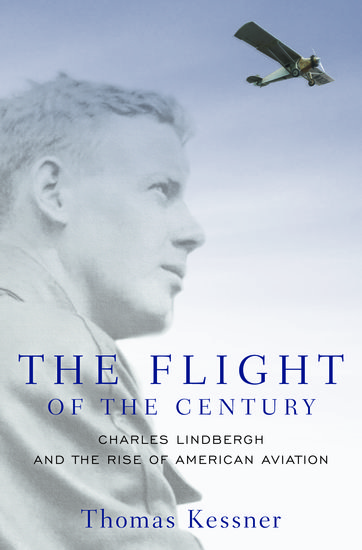By Thomas Kessner
He came as it were from nowhere, setting out on May 20, 1927 on a journey. The non-stop New York to Paris flight was a dream of many great aviators, and they had failed — many of them tragically — to achieve it. Six, all with sterling war records, had died or disappeared trying. The prevailing theory of the experts was to put together a crew of three or four, build a big plane to withstand the stresses and turbulence of the transatlantic flight, strap on as many engines as you can, and fill the fuel tanks to the brim.
Charles Lindbergh, an unknown postal flier, challenged this approach. He scraped together the money for a craft of his own design: tiny, sleek, and as light as possible (not even a radio). He would make the 33 hour trip alone on a course he had sketched out himself. Tall, young, and impossibly handsome, a Midwestern innocent taking on the Atlantic by himself, he put his life on the line (“sleep is death”) competing against the biggest names in aviation. And he bested them all.
Even when they did make it across the ocean (as Richard Byrd and Clarence Chamberlin did within weeks of his flight), their flights were barely saved from disaster. His was picture perfect. In air-crazed Paris — and it was Paris’s frenzied welcome that set the tone for the rest of the world, including the USA — he was lionized for the gracious way that he shared his victory with those who had come before and with those who had died to make his world free. Moreover, the other fliers were tainted by war. They represented aviation’s wrong turn, its misguided use for killing during World War I. He was clean, wholesome, and a symbol of aviation’s better possibilities.

In this greedy age, he refused the blandishments of sponsors, movie producers and would-be patrons, turning his back on millions of dollars of easy money. In this age of “normalcy,” of sports heroes and movie stars, of corporate business and unionized labor, he offered America an example of transporting individual achievement, genuine courage, and solid integrity.
It is impossible today to comprehend the scale of his popularity, the void he filled in a bloody era searching for fresh heroes and new departures. War on a scale no one had ever imagined had drained the world of optimism. And in an age desperately searching for a moral equivalent of war, he demonstrated transcendence without menace.
In Paris, the wily American Ambassador Myron Herrick worked a remarkable transformation. Under his admiring but firm hand, this unlettered fly boy became a nonpareil agent of American diplomacy, impressing the world with his modesty, grace, and dignity. Thereafter, tutored by a coterie of advisers, he led American aviation to world dominance.
Yet the Lindbergh story comes with a grave caveat. Like so many others, when he was removed from his own area of excellence, the graceful hero exposed a cloven hoof. As he turned to philosophy and politics, he revealed a deep racism that led to an open flirtation with Nazism.
Thomas Kessner is Distinguished Professor of History at the City University of New York Graduate Center and the author of The Flight of the Century: Charles Lindbergh and the Rise of American Aviation, which will be released in paperback later this year. His other books include Capital City: New York City and the Men Behind America’s Rise to Dominance, 1860-1900 and Fiorello H. LaGuardia and the Making of Modern New York, which was a New York Times Notable Book.
Subscribe to the OUPblog via email or RSS.
Subscribe to only American history articles on the OUPblog via email or RSS.
View more about this book on the ![]()
![]()


Recent Comments
There are currently no comments.